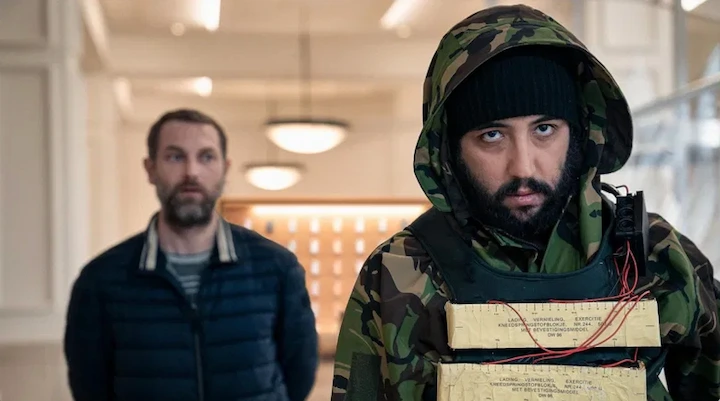Inside the True Heroes of Netflix’s iHostage: Life, & the Cops Who Saved the Day
Netflix’s iHostage dramatizes a hostage crisis at Amsterdam’s Apple Store, inspired by actual events from Feb. 22, 2022. The film also salutes the courage of the police, negotiators, and tactical officers who risked their lives to end the situation peacefully.
This article examines the characters based on real people, the film’s comparison to actual events, and the creative liberties taken for privacy reasons. Dutch law enforcement, specifically the Special Intervention Service (DSI) and its negotiation tactics, also receive a mention.
If you’ve been wondering about characters such as Kees van Zanten or Lynn or the work of negotiators like Willem and Martin, we have the answers. The narrative explores the blurring lines between fiction and accurate crime dramatizations.

Kees Van Zanten Reflects A Real Amsterdam Police Chief
The cool, collected police chief in iHostage, Kees van Zanten, was inspired by a real-life officer: Frank Paauw. Paauw was the police chief of Amsterdam during the real Apple Store crisis; he oversaw the response. Paauw, with over 42 years of experience, led his team through some tense periods, much like Kees did in the film.
While iHostage never explores Kees’ backstory, Paauw’s life has been well-chronicled. He has worked as a high-ranking official in Rotterdam, was a professional football player, and even worked with UEFA. In 2024, he left his job as police chief to become head of the Royal Netherlands Football Association.
The show fictionalizes Kees’ name and eliminates personal details to maintain the focus on the operation. However, his leadership in controlling the situation and ensuring the well-being of the hostages is what truly reflects Paauw’s leadership.
His presence was pivotal, from directing the control room to coordinating with the DSI. The film gets its essence while respecting his privacy — a potent look at crisis leadership in Dutch law enforcement.
Lynn Is Based On Real-life Hostage Negotiators Behind The Scenes
In the film, Lynn gets up close and personal with one of the highly trained negotiators, never losing her composure, while appearing determined, empathetic, and calm even under intense pressure.
Lynn may be a fictional name, but her role is a very real one. She is the female negotiator who initially sought a relationship with Abdel Rahman Akkad, who masterminded the hostage crisis.
Akkad cut off communication with the female negotiator after a time, both in real life and in the film. When he told him he wanted to talk to a man instead. This scene in the movie is based on real-life events and illustrates how negotiation dynamics are shaped by entrenched gender biases or psychological triggers.
The actual negotiators were under high-stakes pressure. They needed to build Akkad’s trust, keep him calm, and learn relevant details. It’s through Lynn’s character that this reality is brought into focus on screen, helping the audience appreciate the burden of emotion and tactical thinking that comes in moments like these.
The film does take creative license to shape her story, but the essence of Lynn’s character pays tribute to the unsung negotiators behind the scenes who helped bring the incident to a bloodless conclusion. Hostage negotiator in the Hostage Real Amsterdam Apple Store crisis, police communicate with DSI negotiators.
Willem: The Veteran Deal Maker Who Was the Male Voice on the Call
Willem, an experienced police negotiator, was the voice that eased Akkad’s tensions during the Apple Store standoff. Lynn isn’t named in the film, though his spirit is there in the male negotiator who replaced him.
Willem was on his way to his holiday home when he received the urgent call. He is rushed to the headquarters immediately, indicating his commitment. Willem’s cool, strategic conversations enabled the police to identify Akkad and gain a better understanding of his motives.
Akkad, angry at the prosecutors and weighed down by past convictions, shared more with Willem than he did with anyone. He also, at one point, requested water for a hostage. Willem declined to deliver it himself, suggesting a robot instead — a decision that left the hostage able to make a daring escape.
This nuance, recreated in iHostage, illustrates how real-life negotiators strike a balance between empathy and tactical decision-making. Willem’s work not only stymied Akkad but also aided the DSI in securing the final move. After the operation, Willem reunited with his family, as the film’s version of the negotiator does with his family.
Martin With The Broom Closet Hostages: A Further Layer Of Calm In The Chaos
Mark, a secondary negotiator in iHostage, is based on Martin, a real-life police officer who stayed on the phone constantly with the hostages hiding in a broom closet. Willem conversed with Akkad while Martin operated from a car parked outside Café Americain. And he offered emotional support and tactical updates to Alex Manuputty and three others.
Martin was not in the control room. He remained near the scene, issuing direct guidance to those hiding nearby. His calm voice and clear orders helped prevent the hostages from panicking, which could have put Akkad on notice of their whereabouts.
Martin’s character tends to play second fiddle to the negotiator communicating with the perpetrator, but his role was essential. He kept the line open, comforting the victims and keeping them going until they were rescued. The name of the character he portrays in the film is not the same, but his role is a foundation of the successful operation.
How Netflix’s iHostage Strikes A Balance Between Fact And Fiction
iHostage is “inspired by a true story,” not “based on” one. That distinction matters. The creators — director Bobby Boermans and writer Simon de Waal — took care to protect real identities and respect trauma victims, changing names, locations, and details. For example, consider the case of the Bulgarian hostage who requested anonymity after the fact.
However, although Kees, Lynn, Winston, and Mark are pseudonyms, their actions embody real human beings. The crisis was handled with precision by the Special Interventions Service (DSI). From the on-the-ground pursuit to the negotiation to the final takedown, their work was complex, coordinated, and courageous.
Netflix made some events dramatic and invented personal backstories for its characters. For its character still, the essential facts hold: real-life hostages were held, the suspect had a gun, and negotiators spoke with him until tactical units could step in.
The last rescue mission, including the high-speed takedown, mimics the real-life ending. iHostage clarifies to the public what occurred even as it shields those involved directly. It’s a tale of crisis response, mental health, communication, and silent heroism.
FAQs
Is Kees van Zanten a real person?
Yes, his character is based on Frank Paauw, the former police chief of Amsterdam.
Was Lynn a real negotiator?
She is the actual female negotiator who initially spoke to Akkad before he requested a male negotiator.
The real male negotiator in iHostage.
Willem, a veteran police officer, was the actual negotiator who then took over the discussion with Akkad.
Was it a movie-style hostage escape?
Yes, the hostage was rescued when water was brought by a robot — an accurately portrayed event in the movie.
Why the change in names in the movie?
Names and specific details have been changed to protect hostages, police, and their families.
Final Words
iHostage reveals the courage, tactics, and improvisation that lie at the heart of a real-life crisis. By weaving together real events with its fictional storytelling, it pays respect to the unsung heroes — negotiators, commanders, officers — who save lives while seeking no limelight. It is a reminder that behind every calm voice on the line or commander in the control room, a real human is making split-second calls that can save lives.
Table of Contents

